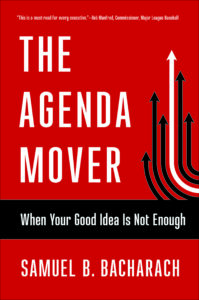Be An Agenda Mover
It’s not enough to have an idea.
Ideas without action, without execution, without forward-momentum don’t matter. To make a difference, you need to have the skills to turn an idea into reality.
Leaders are people who turn ideas into something tangible, turning promises into results.
It’s a skill that anyone can learn. And Samuel B. Bacharach, the author of The Agenda Mover: When Your Good Idea Is Not Enough, is an expert in execution. He is also co-founder of the Bacharach Leadership Group, which focuses on training leaders in the skills of the Agenda Mover, and is the McKelvey-Grant Professor at Cornell University.
I recently had the opportunity to ask Sam about his newest book and turning ideas into reality.
Develop the Qualities of an Agenda Mover
Having a great idea is not enough. You teach a process for taking an idea into actionable reality. Before we go into your process, what leadership qualities are essential to being an effective agenda mover?
First and foremost, Agenda Movers keep their egos in check. They are aware that – no matter how good they think their idea is—there may be other perspectives out there. They understand that confidence is one thing, but they know ego can lead to delusion.
Second, Agenda Movers are deeply empathetic. I use that word in a very specific way, meaning that Agenda Movers are capable of standing in the shoes of other people and are capable of seeing the world from varied perspectives. They can see their agenda not only from their perspective but also from the perspective of others.
Third, Agenda Movers tactically focus. They are mindful of small details and tactics. They understand that charisma, bombastic ideas, and grand promises work only up to a point and that what is really needed to get things done are micro-behavioral skills.
Lastly, Agenda Movers understand that they can’t do it alone. To get anything done they need to have others in their corner. They understand the importance of coalitions, and they are able to adopt a coalition mindset.
If you look at the great Agenda Movers out there—these are the characteristics they all share.
Anticipate Motivations
The first step of your strategic blueprint is to anticipate others’ agendas and know where they’re coming from. I recall one person just totally missing it, oblivious to what seemed to be obvious signs. How do you help aspiring leaders to be more situationally aware of others and their motivations?
I think this is the number one mistake leaders make: They don’t spend enough time focusing on where others are coming from.
I remember years ago a student of mind was asking for advice on defending her dissertation in front of five faculty members I knew. The main advice I gave her was to stop focusing on her dissertation and instead to focus on the dissertations and research that the members of the committee had done. Simply put, I told her, “You know where you’re coming from. Make sure you know where they are coming from.”
Good Agenda Movers do their homework and I mean that literally. They dedicate time to figuring out there others stand, how they think, and what they want. They don’t presume they are born with situational awareness—they develop it and work on it.
Too often we look for shortcuts in trying to figure out the agendas of others. We think that if we understand their background or their personality, we can generalize their motivation and intention. This belief is both lazy and wrong. For most people, whether in organizations or in politics, motivation is determined by the specific agenda, not simply by personality.
An individual may be a staunch traditionalist on one issue and a complete revolutionary on another issue. Leaders who make quick summations about the agendas of others and don’t do their homework are bound to make mistakes.
How to Deal With Resistance
Gaining traction and initial support is crucial. If you’re met with resistance, what do you do?
First of all, resistance should never come as a surprise to anyone. All leaders, all organizational actors, will face resistance—it’s just a question of when and how much.
In our political and organizational systems, resistance is part and parcel of the checks and balances that improve what we’re trying to accomplish.
So for starters, don’t let resistance throw you for a loop. Don’t let it shock you. Don’t let it root you to the ground. Instead, you should expect it and have a plan to deal with it.
I argue in my book that there are only a handful of ways people can resist an idea. To the surprise of my students, this really isn’t a daunting challenge. There are a limited number of ways resistance can argue against any idea and leaders can easily defend against these arguments with a little preparation. Once you’re able to categorize the arguments of resistance, you will be able to apply your counter arguments of justification.
Know the 3 Types of Resistors
What’s the best way to deal with resistors?
The first thing you need to understand is what type of resistance you’re facing.
In my book I look at three main types of resistors in an organizational context: active resistors, passive resistors, and internal resistors.
While I always support leaders building a wide swath of support, they might have the hardest time convincing active resistors to join their coalition. At some point, an Agenda Mover should move on and not waste his or her time.
Good Agenda Movers focus on talking with passive resistors. They are those actors who aren’t actively undermining your efforts, but certainly are not helping them, either. Since they are on the fence, so to speak, a leader can be clever and find ways to incorporate them into his or her coalition by presenting potential benefits to them.
Lastly, there are internal resistors—those who sneak into a coalition in a Trojan Horse. Agenda Movers can prevent them from showing up by monitoring their coalition and making sure they don’t let team traction and momentum slip after an initial surge.
How to Sustain Momentum
Once you get going, you need to sustain the momentum. How do you use small victories effectively? Why do some ideas die in this stage?
Some leaders are great at mobilizing political support for their agenda. They’re great at convincing people of the need for innovation and change. They’re great at getting others to join them. But they drop the ball once they mobilize support. It’s sort of like the politician who gets elected but doesn’t deliver.
These leaders stop doing their homework. They stop thinking about the team. They lose their focus and start looking toward the horizon for another big project or a big career move. As a result, they leave it to their coalition to work out the day-to-day details of implementing a new idea.
Agenda Movers can’t relax once they start building some traction. If anything, they need to work harder to drive momentum by not only celebrating small victories but also by providing the right resources and maintaining optimism. They have to supplement the prudent political competence they have used to gain support with a managerial capacity to make sure that things keep on moving. Like I said, it is one thing to gain support and it is another to deliver.
Is there one step in the agenda moving process where most leaders fail?
No, I don’t think there is one particular step that everyone misses. The problem is, and I truly believe this, that you have to follow all the steps. You have to have the skills for mobilizing support for your agenda and that requires political competence. And you have to have the skills to go the distance and that requires managerial competence.
Everyone has their strengths and their weaknesses. To some, political competence — the ability to read the intentions of others and navigate the organizational landscape — comes easier.
To others, managerial competence comes easy. Some leaders are good at managing team dynamics while also keeping teams driven and focused.
What proves the most challenging aspect for leaders is to find the balance between political and managerial competence. In this day and age, leaders need both of these competencies. You have to get people in your corner and go the distance.
These techniques are a must-read for an individual wanting to succeed in an organization. Let’s take the concept to a team. How do you teach a team the ‘agenda mover’ mindset?
 If you look around at what’s happening in our organizations and political systems, you realize that everything has become a complex maze. Hierarchies have been replaced by networks. Departments have been replaced by projects. Teams are global, turf is ubiquitous, and everything is happening in real time. In this context, we need to focus on the key skills of execution. Simply put, can you move an agenda?
If you look around at what’s happening in our organizations and political systems, you realize that everything has become a complex maze. Hierarchies have been replaced by networks. Departments have been replaced by projects. Teams are global, turf is ubiquitous, and everything is happening in real time. In this context, we need to focus on the key skills of execution. Simply put, can you move an agenda?
Without that ability, your innovation and change efforts will come to nothing.
Moving an agenda won’t happen because of your charisma or because everyone loves you. It will happen because of the core micro skills that will allow you to overcome resistance, build coalitions, and sustain momentum for results. These skills must be learned. They are specific. They must be practiced so they become part and parcel of how we act as leaders. At the Bacharach Leadership Group, we focus on giving people these skills so that they can become Agenda Movers in a world that demands of leaders one thing: delivering results. Moving agendas is something that can be mastered.
The Agenda Mover: When Your Good Idea Is Not Enough

